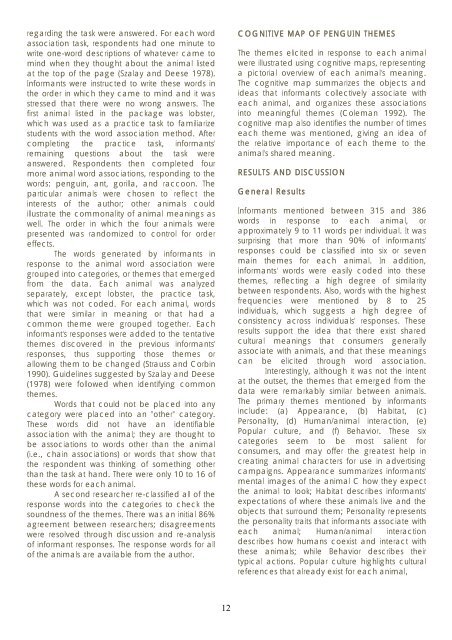Marketing Animals - Antennae The Journal of Nature in Visual Culture
Marketing Animals - Antennae The Journal of Nature in Visual Culture
Marketing Animals - Antennae The Journal of Nature in Visual Culture
Create successful ePaper yourself
Turn your PDF publications into a flip-book with our unique Google optimized e-Paper software.
egard<strong>in</strong>g the task were answered. For each word<br />
association task, respondents had one m<strong>in</strong>ute to<br />
write one-word descriptions <strong>of</strong> whatever came to<br />
m<strong>in</strong>d when they thought about the animal listed<br />
at the top <strong>of</strong> the page (Szalay and Deese 1978).<br />
Informants were <strong>in</strong>structed to write these words <strong>in</strong><br />
the order <strong>in</strong> which they came to m<strong>in</strong>d and it was<br />
stressed that there were no wrong answers. <strong>The</strong><br />
first animal listed <strong>in</strong> the package was lobster,<br />
which was used as a practice task to familiarize<br />
students with the word association method. After<br />
complet<strong>in</strong>g the practice task, <strong>in</strong>formants'<br />
rema<strong>in</strong><strong>in</strong>g questions about the task were<br />
answered. Respondents then completed four<br />
more animal word associations, respond<strong>in</strong>g to the<br />
words: pengu<strong>in</strong>, ant, gorilla, and raccoon. <strong>The</strong><br />
particular animals were chosen to reflect the<br />
<strong>in</strong>terests <strong>of</strong> the author; other animals could<br />
illustrate the commonality <strong>of</strong> animal mean<strong>in</strong>gs as<br />
well. <strong>The</strong> order <strong>in</strong> which the four animals were<br />
presented was randomized to control for order<br />
effects.<br />
<strong>The</strong> words generated by <strong>in</strong>formants <strong>in</strong><br />
response to the animal word association were<br />
grouped <strong>in</strong>to categories, or themes that emerged<br />
from the data. Each animal was analyzed<br />
separately, except lobster, the practice task,<br />
which was not coded. For each animal, words<br />
that were similar <strong>in</strong> mean<strong>in</strong>g or that had a<br />
common theme were grouped together. Each<br />
<strong>in</strong>formant's responses were added to the tentative<br />
themes discovered <strong>in</strong> the previous <strong>in</strong>formants'<br />
responses, thus support<strong>in</strong>g those themes or<br />
allow<strong>in</strong>g them to be changed (Strauss and Corb<strong>in</strong><br />
1990). Guidel<strong>in</strong>es suggested by Szalay and Deese<br />
(1978) were followed when identify<strong>in</strong>g common<br />
themes.<br />
Words that could not be placed <strong>in</strong>to any<br />
category were placed <strong>in</strong>to an "other" category.<br />
<strong>The</strong>se words did not have an identifiable<br />
association with the animal; they are thought to<br />
be associations to words other than the animal<br />
(i.e., cha<strong>in</strong> associations) or words that show that<br />
the respondent was th<strong>in</strong>k<strong>in</strong>g <strong>of</strong> someth<strong>in</strong>g other<br />
than the task at hand. <strong>The</strong>re were only 10 to 16 <strong>of</strong><br />
these words for each animal.<br />
A second researcher re-classified all <strong>of</strong> the<br />
response words <strong>in</strong>to the categories to check the<br />
soundness <strong>of</strong> the themes. <strong>The</strong>re was an <strong>in</strong>itial 86%<br />
agreement between researchers; disagreements<br />
were resolved through discussion and re-analysis<br />
<strong>of</strong> <strong>in</strong>formant responses. <strong>The</strong> response words for all<br />
<strong>of</strong> the animals are available from the author.<br />
12<br />
COGNITIVE MAP OF PENGUIN THEMES<br />
<strong>The</strong> themes elicited <strong>in</strong> response to each animal<br />
were illustrated us<strong>in</strong>g cognitive maps, represent<strong>in</strong>g<br />
a pictorial overview <strong>of</strong> each animal's mean<strong>in</strong>g.<br />
<strong>The</strong> cognitive map summarizes the objects and<br />
ideas that <strong>in</strong>formants collectively associate with<br />
each animal, and organizes these associations<br />
<strong>in</strong>to mean<strong>in</strong>gful themes (Coleman 1992). <strong>The</strong><br />
cognitive map also identifies the number <strong>of</strong> times<br />
each theme was mentioned, giv<strong>in</strong>g an idea <strong>of</strong><br />
the relative importance <strong>of</strong> each theme to the<br />
animal's shared mean<strong>in</strong>g.<br />
RESULTS AND DISCUSSION<br />
General Results<br />
Informants mentioned between 315 and 386<br />
words <strong>in</strong> response to each animal, or<br />
approximately 9 to 11 words per <strong>in</strong>dividual. It was<br />
surpris<strong>in</strong>g that more than 90% <strong>of</strong> <strong>in</strong>formants'<br />
responses could be classified <strong>in</strong>to six or seven<br />
ma<strong>in</strong> themes for each animal. In addition,<br />
<strong>in</strong>formants' words were easily coded <strong>in</strong>to these<br />
themes, reflect<strong>in</strong>g a high degree <strong>of</strong> similarity<br />
between respondents. Also, words with the highest<br />
frequencies were mentioned by 8 to 25<br />
<strong>in</strong>dividuals, which suggests a high degree <strong>of</strong><br />
consistency across <strong>in</strong>dividuals' responses. <strong>The</strong>se<br />
results support the idea that there exist shared<br />
cultural mean<strong>in</strong>gs that consumers generally<br />
associate with animals, and that these mean<strong>in</strong>gs<br />
can be elicited through word association.<br />
Interest<strong>in</strong>gly, although it was not the <strong>in</strong>tent<br />
at the outset, the themes that emerged from the<br />
data were remarkably similar between animals.<br />
<strong>The</strong> primary themes mentioned by <strong>in</strong>formants<br />
<strong>in</strong>clude: (a) Appearance, (b) Habitat, (c)<br />
Personality, (d) Human/animal <strong>in</strong>teraction, (e)<br />
Popular culture, and (f) Behavior. <strong>The</strong>se six<br />
categories seem to be most salient for<br />
consumers, and may <strong>of</strong>fer the greatest help <strong>in</strong><br />
creat<strong>in</strong>g animal characters for use <strong>in</strong> advertis<strong>in</strong>g<br />
campaigns. Appearance summarizes <strong>in</strong>formants'<br />
mental images <strong>of</strong> the animal C how they expect<br />
the animal to look; Habitat describes <strong>in</strong>formants'<br />
expectations <strong>of</strong> where these animals live and the<br />
objects that surround them; Personality represents<br />
the personality traits that <strong>in</strong>formants associate with<br />
each animal; Human/animal <strong>in</strong>teraction<br />
describes how humans coexist and <strong>in</strong>teract with<br />
these animals; while Behavior describes their<br />
typical actions. Popular culture highlights cultural<br />
references that already exist for each animal,












